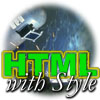It's the Strands that Make the Web
 It's the Strands that Make the Web
It's the Strands that Make the Web
So why is it called the Web anyway? In the first HTML with Style tutorial, I mentioned that HTML is a hypertext language. In fact, that's HTML's most important function. Now I'm going to explain this and talk about links; everyone loves them, they're all over the place. You can get lost in them. This week you'll learn you how to sort them out.
As is the practice here in HTML with Style, we'll take a look at the concepts behind hyperlinks before going into how to put them into your documents. Links will make a whole lot more sense if you understand what their reason for being is. So I'll talk a bit about resources and where to find them.
This tutorial does get a bit technical at times, but don't worry. Even if you don't understand all of the concepts described here after your first pass, they'll become obvious after you've seen some examples.
As a bonus, you'll get an introduction to HTML attributes - the next most important concept in HTML after elements, which we examined in the first tutorial.
Let's take a look at what's in this week's tutorial:
- Resources and URIs
- Anatomy of an http URL
- Relative URLs
- Other URL schemes
- Understanding Hyperlinks: Heads or Tails?
- An Introduction to Element Attributes
- Dropping Anchors into HTML
- Document Links
By the end of this tutorial, you'll know everything there is to know about linking in HTML documents, and that's all you need to know to make a Web page. The rest is just the icing on the cake. But before you get there, you'll need to learn about resources.
Produced by Stephanos Piperoglou
All Rights Reserved. Legal Notices.
URL: https://www.webreference.com/html/tutorial2/
Created: June 11, 1998
Revised: June 11, 1998




 Find a programming school near you
Find a programming school near you